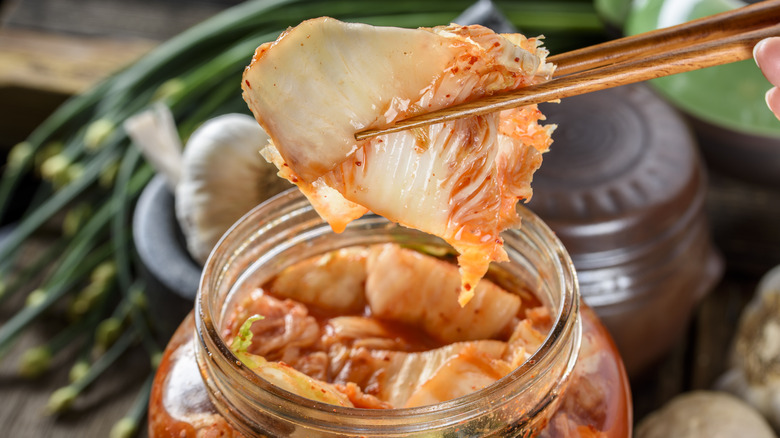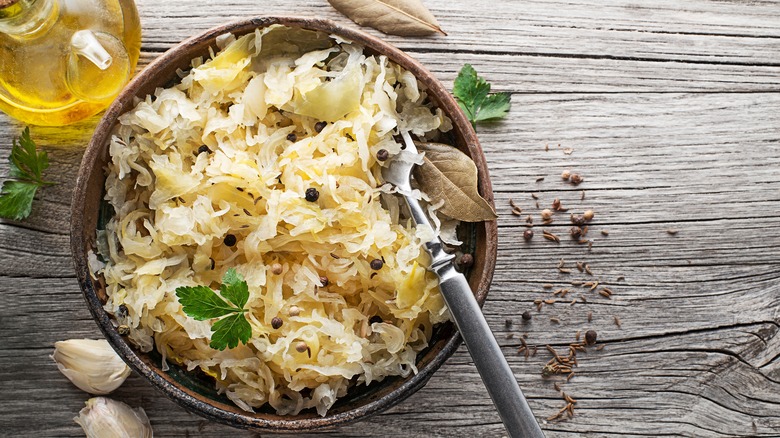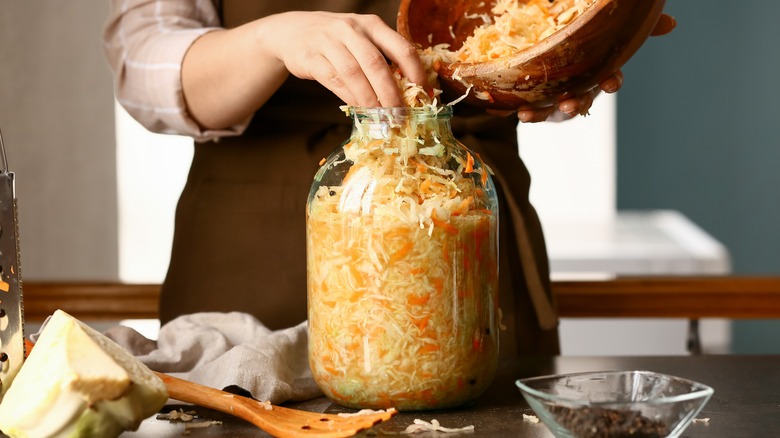What Separates Kimchi From Sauerkraut?
Cabbage is undoubtedly the vegetable of the moment, and the only thing we love more than a perfectly seared wedge of the conehead cabbage is using it to make a jar of something fermented and probiotic like sauerkraut or kimchi. These two traditional dishes share a lot in common, but while the process of making them is similar, kimchi and sauerkraut differ in terms of added ingredients, flavor profiles, and origins.
Both dishes evolved as a way to preserve vegetables through the winter to take advantage of their nutrients. Kimchi is from South Korea, and the process of making and sharing it, known as Kimjang, is actually listed on UNESCO's Intangible World Heritage list.
Meanwhile, sauerkraut is most commonly associated with Germany and the French region of Alsace ... though it actually dates back to ancient China. Cabbage was often eaten with rice as a cheap and filling meal, and fermenting it was commonplace. The Tartars then brought the practice with them to Germany, where it was dubbed sauerkraut, or "sour cabbage."
Ingredients needed for kimchi and sauerkraut
It's no surprise that cabbage, a hardy vegetable that grows in abundance in both South Korea and Germany, is often used for both kimchi and sauerkraut. If you've ever purchased a foot-long, 4-pound Napa cabbage, you'll understand that preserving it is one of the only ways to get through an entire head without wasting any.
But one of the main differences between the two foods is that sauerkraut must be made from cabbage, but kimchi can be made from anything. Though Napa cabbage is the most common base for kimchi, it can be made with radishes (generally the large Korean radishes), cucumbers, or any other vegetable. Getting creative with kimchi is encouraged, and you can even use watermelon rinds for a spicy-sweet kimchi.
Sauerkraut, on the other hand, is often made with white, green, or red round cabbages, like the varieties generally available in Germany. Sauerkraut is also typically shredded prior to fermentation, while kimchi may be fermented and later served in large chunks, giving it less of a uniform texture.
Flavoring and fermenting kimchi and sauerkraut
Kimchi is typically made with gochugaru, a Korean chili powder. Though it's mild when served in small doses, it's added to kimchi in large amounts to give the dish that flavorful, spicy kick. Fish sauce, ginger, scallions, garlic, sugar, and other flavorings are also packed in with the brined vegetables. However, non-spicy kimchi alternatives exist, like baek kimchi, or "white kimchi," which is made with a fruity brine and contains no gochugaru.
Homemade sauerkraut, on the other hand, is seasoned more simply. It can be made with nothing more than cabbage and salt, though spices like caraway seeds, juniper seeds, and bay leaves are often added for extra flavor.
After being brined in salt, naturally occurring bacteria on the surface of cabbage interacts with the sugars in the veggie to create lactic acid. This process is used for both kimchi and sauerkraut, but the latter is typically left to ferment for much longer.
Kimchi might be left in jars to ferment for a few days at room temperature, while sauerkraut could be left to ferment for up to a month. The accumulation of lactic acid gives sauerkraut its tangy flavor, while the shorter fermentation time and other ingredients (particularly fish sauce and gochugaru) gives kimchi more of a spicy umami flavor. This makes kimchi great for serving with eggs or rice, while sauerkraut is traditionally served with potatoes and sausages, or used to top hot dogs.



